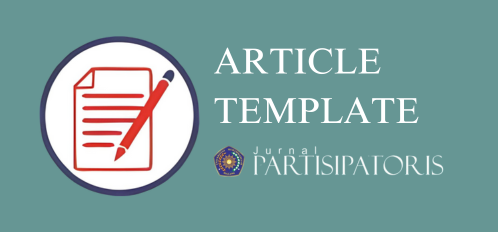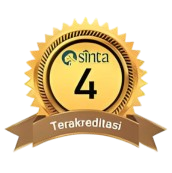The RESILIENCE OF URBAN KAMPONG COMMUNITY IN AFTERMATH THE PANDEMIC
DOI:
https://doi.org/10.22219/jp.v6i1.32191Abstract
The impacts of the Covid-19 Pandemic have struck the economic and public health of urban residents. As a community who live in densely populated areas around Pasar Besar Malang, kampong inhabitants must cope with the outbreak as well as recover in the aftermath the pandemic using their own resources. This article investigated the role of the collective memory contributed to forming local knowledge to make the best way to deal with the pandemic turbulences as well as how people started to initiate resilience using the urban infrastructure resources in post-outbreak. Utilizing the qualitative method, the results show two essential findings. First, the collective memory of the past plague was absent in communities’ everyday life for a long time of period which made people have no simple guidance to overcome the pandemic impacts. The politics of ethnic segregation in housing during Colonial Era contribute for keeping distance people from the outbreak history. Second, several urban infrastructures such as clean water supply and public electricity which were properly provided for kampong community devoted in composing resilience during until after the pandemic. Ultimately, using those physical infrastructures the social structures were transformed.
Downloads
References
Alexander, J. T. (2003). Bubonic Plague in Early Modern Russia, Public Health and Urban Disaster. Oxford University Press.
Atta-ur-Rahman, Shaw, R., Surjan, A., & Parvin, G. A. (2016). Urban Disasters and Approaches to Resilience. In Urban Disasters and Resilience in Asia. Elsevier Ltd.
Bagcchi, S. (2020). Stigma during the COVID-19 pandemic. https://www.ncbi.nlm.nih.gov/pmc/articles/PMC7314449/
Banai, R. (2020). Pandemic and the planning of resilient cities and regions. Cities, January.
Bankoff, G. (2003). Constructing Vulnerability: The Historical, Natural and Social Generation of Flooding in Metropolitan Manila. Disasters, 27(3), 224–38. https://doi.org/doi: 10.1111/1467-7717.00230.
Blaikie, P., Cannon, T., Davis, I., & Wisner, B. (2005). At Risk: Natural Hazards, People’s Vulnerability, and Disasters (B. Blaikie, P, Cannon, T, Davis, I, Wisner (ed.); 3rd ed.). Taylor & Francis e-Library.
Chu, Z., Cheng, M., & Song, M. (2021). What determines urban resilience against COVID-19: City size or governance capacity? Sustainable Cities and Society, 75(January).
CNN Indonesia. (2021). IDI Jatim soal Data Nol Kematian Covid-19: Coba Lihat Kuburan. https://www.cnnindonesia.com/nasional/20210723110456-20-671205/idi-jatim-soal-data-nol-kematian-covid-19-coba-lihat-kuburan
Colombijn, F. (2014). Under Construction: The Politics of Urban Space and Housing during the Decolonization of Indonesia, 1930-1960. KITLV.
Cresswell, J. W. (2017). Research Design; Pendekatan Metode Kualitatif, Kuantitatif dan Campuran (4th ed.). Pustaka Pelajar.
Gizdic, A., Baxter, T., Barrantes-Vidal, N., & Park, S. (2023). Social connectedness and resilience post COVID-19 pandemic: Buffering against trauma, stress, and psychosis. Psychiatry Research Communications, 3(2), 100126. https://doi.org/10.1016/j.psycom.2023.100126
Halbwachs, M. (1980). The Collective Memory. Harper and Row.
Janti, N. (2019, June 30). Impor Beras Burma Sebabkan Wabah Pes di Jawa. Historia.Id. https://historia.id/sains/articles/impor-beras-burma-sebabkan-wabah-pes-di-jawa-vgX1V/page/1
Kakderi, C., Oikonomaki, E., & Papadaki, I. (2021). Smart and resilient urban futures for sustainability in the post covid‐19 era: A review of policy responses on urban mobility. Sustainability (Switzerland), 13(11). https://doi.org/10.3390/su13116486
Leach, M., MacGregor, H., Scoones, I., & Wilkinson, A. (2021). Post-pandemic transformations: How and why COVID-19 requires us to rethink development. World Development, 138, 105233. https://doi.org/10.1016/j.worlddev.2020.105233
Luwis, S. (2020). Epidemi Penyakit PES di Malang 1911-1916. Kendi.
Maquiling, K. S. M., Languayan, K. A., & Aying, J. A. (2023). Post-Pandemic Urban Resilience Imperatives: Examining Practices of Philippine Local Governments. In K. Takahashi, S. Bharule, S. Kudo, & K. S. Ram (Eds.), Rethinking Cities for Resilience and Growth in the Post-COVID-19 World. Asian Development Bank Institute.
Martínez, L., & Short, J. R. (2021). The pandemic city: Urban issues in the time of covid-19. Sustainability (Switzerland), 13(6), 1–10. https://doi.org/10.3390/su13063295
Maxwell, J. A. (1996). Qualitative Research Design An Interactive Aprroach. SAGE Publications.
Miles, M. B., Huberman, a M., & Saldana, J. (2014). Qualitative Data Analysis A Methode Sourcebook. In Sage Publication (3rd ed.).
Oliver-Smith, A. (2002). Theorizing Disasters: Nature, Power and Culture. In S. M. Hoffman & A. Oliver-Smith (Eds.), Catastrophe and culture: The anthropology of disaster (pp. 23–47). School of American Research.
Payonga, L. R., & Ihara, T. (2023). Beyond Access to Electricity: Surviving a 21st Century Pandemic Without It. In K. Takahashi, S. Bharule, S. Kudo, & K. S. Ram (Eds.), Rethinking Cities for Resilience and Growth in the Post-COVID-19 World. Asian Development Bank Institute.
Qodarsasi, U., Huda, R. N., & Zuma, U. A. (2021). Strengthening communities’ disaster resilience during COVID-19 time: A case of Muhammadiyah in Indonesia. Simulacra, 4(2), 229–245. https://doi.org/10.21107/sml.v4i2.11952
Ramadhan, B. (2021, January 5). Pandemi Covid-19, Kemiskinan di Kota Malang Meningkat. https://www.republika.co.id/berita/qmfzfn330/pandemi-covid19-kemiskinan-di-kota-malang-meningkat
Santiago-Alarcon, D., & MacGregor-Fors, I. (2020). Cities and pandemics: Urban areas are ground zero for the transmission of emerging human infectious diseases. Journal of Urban Ecology, 6(1), 1–3. https://doi.org/10.1093/jue/juaa012
Sharifi, A. (2020). Urban resilience assessment: Mapping knowledge structure and trends. Sustainability (Switzerland), 12(15), 1–18. https://doi.org/10.3390/SU12155918
Sharifi, A., & Khavarian-Garmsir, A. R. (2020). The COVID-19 pandemic: Impacts on cities and major lessons for urban planning, design, and management. Science of the Total Environment, 749, 1–3. https://doi.org/10.1016/j.scitotenv.2020.142391
Shave, S., Zazu, C., Tidball, K., & O’Donoghue, R. (2009). Local Knowledge As a Source of Community. INDILINGA- African Journal of Indigenous Knowledge Systems, 8(2), 218–229.
Shaw, R., Atta-ur-Rahman, Surjan, A., & Parvin, G. A. (2016). Urban Disasters and Resilience in Asia. In Urban Disasters and Resilience in Asia. https://doi.org/10.1016/C2014-0-01952-1
Sullivan, J. (1986). Kampung and State: The Role of Government in the Development of Urban Community in Yogyakarta. Indonesia, 41, 63–88.
Supriyatno, H. (2020, September 29). Dampak Covid 19, Omset Pedagang Kota Malang Anjlok 50 Persen. https://www.harianbhirawa.co.id/dampak-covid-19-omset-pedagang-kota-malang-anjlok-50-persen/
UN-Habitat. (2021). Cities and Pandemics: Towards a More Just , Green and Healthy Future. https://unhabitat.org/sites/default/files/2021/03/cities_and_pandemics-towards_a_more_just_green_and_healthy_future_un-habitat_2021.pdf
Vale, L. J. (2014). The politics of resilient cities: Whose resilience and whose city? Building Research and Information, 42(2), 191–201. https://doi.org/10.1080/09613218.2014.850602
Villa, S., Jaramillo, E., Mangioni, D., Bandera, A., Gori, A., & Raviglione, M. C. (2020). Stigma at the time of the COVID-19 pandemic. Clinical Microbiology and Infection, 26(11), 1450–1452. https://doi.org/10.1016/j.cmi.2020.08.001
Wang, Q. (2008). On the cultural constitution of collective memory. Memory, 16(3), 305–371. https://doi.org/10.1080/09658210701801467
Wasdani, K. P., & Prasad, A. (2020). The impossibility of social distancing among the urban poor: the case of an Indian slum in the times of COVID-19. The International Journal of Justice and Sustainability, 25(5). https://www.tandfonline.com/doi/full/10.1080/13549839.2020.1754375
Wright, K. (2022). Community Resilience, A Critical Approach. Routledge.
Downloads
Published
How to Cite
Issue
Section
License

This work is licensed under a Creative Commons Attribution-ShareAlike 4.0 International License.
Authors who publish with Jurnal Partisipatoris agree to the following terms:
- For all articles published in the Jurnal partisipatoris, copyright is retained by the authors. Authors give permission to the publisher to announce the work with conditions. When the manuscript is accepted for publication, the authors agree to the automatic transfer of non-exclusive publishing rights to the publisher.
- Authors retain copyright and grant the journal right of first publication with the work simultaneously licensed under a Creative Commons Attribution-ShareAlike 4.0 International License that allows others to share the work with an acknowledgment of the work's authorship and initial publication in this journal.
- Authors are able to enter into separate, additional contractual arrangements for the non-exclusive distribution of the journal's published version of the work (e.g., post it to an institutional repository or publish it in a book), with an acknowledgment of its initial publication in this journal.
- Authors are permitted and encouraged to post their work online (e.g., in institutional repositories or on their website) prior to and during the submission process, as it can lead to productive exchanges, as well as earlier and greater citation of published work (See The Effect of Open Access).











